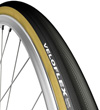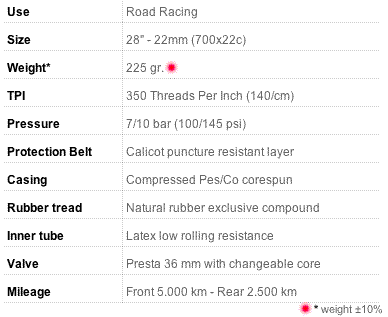
$220 SAVE $130 = 37.0% Western Digital 16.0TB Western Digital Ultrastar DC HC550 3.5-in… in Storage: Hard Drives
|

|

|

|

|
Veloflex Sprinter / Extreme Tubular Tire
Related: gear, Mercedes Sprinter, Road Bikes, tubular, Veloflex

See the official Veloflex web site for the full range of tires.
The Veloflex Sprinter is a little wider and slightly heavier (10g) than its predecessor the Servizio Corse. The Sprinter is a 22mm tire, wider than the Servizio Corse, which is specified at 20mm.
In general, my review of the Veloflex Record applies also to the Veloflex Servizio Corse and the Sprinter.
The Sprinter has a 350 TPI casing compared to a 300 TPI casing for the Servizio Corse, so in theory it should ride a little better and be slightly more puncture resistant. Indeed, it rides very, very nicely, and is very complaint.
The Sprinter has a gum-colored sidewall, but the Extreme is the same tire with a black sidewall, so take your pick.
See pricing at Amazon @AMAZON.
Good choice for the rear wheel
The Sprinter is my default tire of choice for the rear wheel, offering substantial extra tire life over the Record, provided one avoids punctures. But since the front wears much more slowly, I stick to the Veloflex Record on the front, to keep the wheels feeling fast.
Having tired the Veloflex Record on the rear, I do prefer it, because it quickens the handling, most likely not due to the small weight difference, but rather to the more compliant tire carcass. However, wear time is at most 700 miles on the rear for my weight and riding, so the Sprinter remains a better choice for those looking to get a ~1200-1400 mile wear on the rear. Yet it’s not so simple: I have yet to achieve the full wear on the Sprinter, since the rear tire often picks up a cut or puncture in the 800-1100 mile range. Thus, the actual difference in wear time can be much smaller than one might think.
Tire weight

There is always variation and different batches can be slightly lighter or heavier, but Veloflex is pushing the limits in quoting a weight of 225 grams.
I weighed brand new Sprinter tires over many months on my lab scale at the following weights (nominal weight 225g):
- 226g
- 228g, 228g
- 231g = +2.7%
- 236g
- 237g = +5.3%
- 233g = +3.5%
- 242g = +7.5%
- 239g = +6.2%
- 239g = +6.2%
- 235g = +4.4%
- 230g = +2.2%
- 223g
- 222g
Some variation is normal, but when all tires are heavier than spec, that’s cheating. Given my findings with the Record, this finding should come as no suprise; it’s just dishonest marketing.
Tire pressure
I inflate the Sprinter to 120 PSI (I am 180 pounds when lean). Using 115 PSI yields a better ride when pavement is rough, and 125 PSI becomes jarring on rough pavement.
Nominal specifications
Per Veloflex.
I have approached 2500km (1550 miles) time on the rear, but most of the time a puncture kills the tire in the 800-1200 mile range— just the odds. Also, I would not want to ride beyond the 1400 mile range anyway; the tire is showing its wear pretty strongly, being squared off pretty well by 1100 miles (strong 175 pound rider).
| Use | road racing |
| Size | 28" - 22mm (700x22c) |
| Weight | 225 grams ±10% |
| TPI | 350 Threads Per Inch (140/cm) |
| Pressure | 7/10 bar (100/145 psi) |
| Protection belt | Calicot puncture resistant layer |
| Casing | Compressed Pes/Co corespun |
| Rubber tread | Natural rubber exclusive compound |
| Inner tube | Latex low rolling resistance |
| Valve | Presta 36 mm with changeable core |
| Mileage | Front 5.000 km - Rear 2.500 km |
Seagate 22TB IronWolf Pro 7200 rpm SATA III 3.5" Internal NAS HDD (CMR)
SAVE $100



